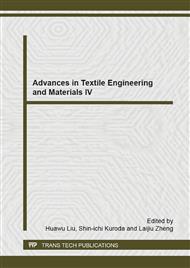p.391
p.395
p.400
p.404
p.410
p.414
p.418
p.423
p.427
Influence of Carbon Source for Carbon Nanotubes Synthesis from Controllable Flame
Abstract:
The flame method is a kind of new method for preparation of carbon nanotubes. The hydrocarbon gas (acetylene, ethylene, methane) or carbon monoxide is often selected as carbon source gas in this method. Carbon monoxide is a kind of effective carbon source gas in preparation of carbon nanotubes from the high temperature flame compared with hydrocarbon gases. The pentacarbonyl iron is served as catalyst precursor in the experiment. Austenitic stainless steel type316 is selected as sampling substrate in the flame experiment. The carbon nanotubes from the controllable flame have graphite well-crystallized and less structural defects relatively. The nanotube diameter consistency is also relatively good. Carbon monoxide began to decompose at higher temperature than that of hydrocarbon gas and its decomposition rate is suitable for the synthesis of carbon nanotubes in the flame. In addition, the carbon monoxide has the ability to split large iron catalyst particles and prefers to react with iron catalyst. But only a few carbon nanotubes mixed with lots of iron catalyst particles, soot and amorphous carbon particles come into being when low mass flow of carbon monoxide is provided.
Info:
Periodical:
Pages:
410-413
Citation:
Online since:
October 2014
Authors:
Price:
Сopyright:
© 2014 Trans Tech Publications Ltd. All Rights Reserved
Share:
Citation:


